Johnny Marr, the celebrated guitarist of The Smiths, is renowned for his distinctive jangly guitar sound that defined an era of indie music. His innovative playing and unique tones have inspired countless guitarists. This article delves into the extensive collection of guitars, amplifiers, and effects that Johnny Marr has utilized throughout his career, primarily focusing on his influential period with The Smiths, offering a comprehensive guide to the gear behind his signature sound.
The Smiths Era Guitars: Crafting a Unique Soundscape
Marr’s guitar choices during his time with The Smiths were crucial in shaping the band’s iconic sound. He employed a diverse range of instruments, each contributing its unique character to his multifaceted playing style.
Rickenbacker: The Jangle-Pop Staple
The Rickenbacker guitar became synonymous with Johnny Marr’s sound, particularly the 330 and 360 models.
1983 Rickenbacker 330 Jetglo
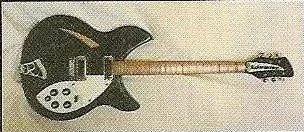 Johnny Marr's 1983 Black Rickenbacker 330, his main guitar during the early Smiths era.
Johnny Marr's 1983 Black Rickenbacker 330, his main guitar during the early Smiths era.
“This is my 1983 Black Rickenbacker 330 that I used throughout The Smiths. I got it from A1 Repairs on Oxford Road in Manchester and it was my main guitar at all the early gigs. It’s the sound of the riff on ‘What Difference Does It Make’ and ‘Reel Around The Fountain’, all of the first album and on other albums too. I still use it now.”
This Jetglo Rickenbacker 330 was Marr’s workhorse in the early days of The Smiths. Acquired from a Manchester repair shop, it powered iconic riffs on their debut album and early singles. Its “button top” style high-gain pickups and rare Grover slimline tuners contributed to its bright, ringing tone, essential to the band’s early sound. Later, this guitar was frequently used on stage by Craig Gannon in 1986.
Rickenbacker 330/12 Fireglo
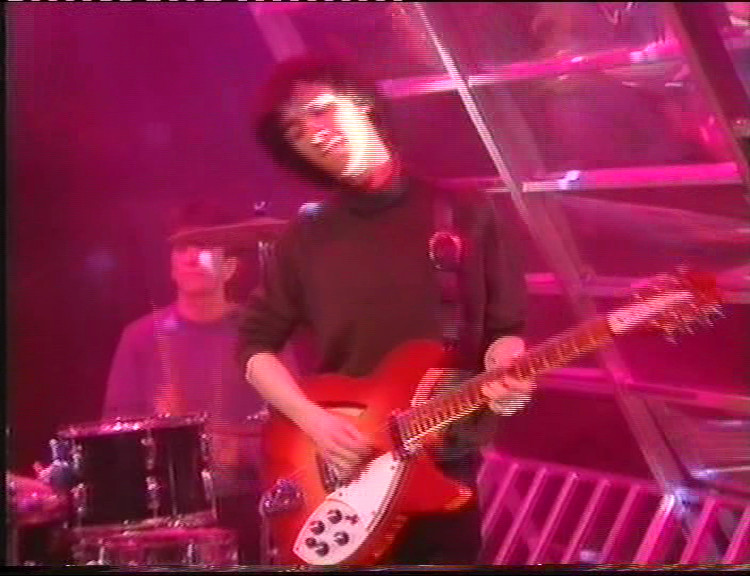 Johnny Marr playing a Fireglo Rickenbacker 330 12-string guitar on Top Of The Pops.
Johnny Marr playing a Fireglo Rickenbacker 330 12-string guitar on Top Of The Pops.
“The [Headmaster Ritual] main riff is two tracks of Rickenbacker. I wasn’t specifically thinking of the Beatles’ “Day Tripper”–even though it sounds like it– but I did think of it as a George Harrison part.”
While Marr is often associated with the 12-string Rickenbacker, it was actually used less frequently than his Telecaster in the studio. This Fireglo 330/12, however, is notably linked to “This Charming Man,” as seen in the Top of the Pops performance. This specific guitar has an interesting history, believed to have belonged to Phil Manzanera of Roxy Music and possibly Roger McGuinn of The Byrds before him. It is characterized by an unbound fretboard and a shorter scale with 20 frets, suggesting a replaced neck.
1964 Rickenbacker 360/12 (Rose Morris Model 1993)
“My 1964 Rickenbacker 12 String that once belonged to Pete Townsend. Used on most Smiths from ‘This Charming Man’ onwards. The 360/12 I’ve got is one of Townshend’s only original ones he didn’t smash. It’s great.”
This iconic 12-string Rickenbacker, previously owned by Pete Townshend of The Who, became a staple for The Smiths’ later work, from “This Charming Man” onward. Marr acquired it from Alan Rogan, who worked for Townshend and other guitar legends. This guitar contributed to the signature chiming sound on many of their beloved tracks.
Gibson: Versatility and Depth
Gibson guitars provided Marr with a different tonal palette, offering warmth, sustain, and a thicker sound compared to the bright Rickenbackers.
1959 Gibson ES-355 (Red)
“I met Sire Records boss Seymour Stein in late 1983 when the Smiths were about to sign to the legendary New York label. Seymour told me that he had once gone to a guitar store on 48th Street with Brian Jones to get him a guitar when the Rolling Stones were in town, so I suggested that if I signed with Sire he should buy me a guitar. We signed the contract on January 2, 1984, and true to his word, Seymour took me down to We Buy Guitars on 48th and bought me the 1959 Gibson 355. I took it back to the Iroquois Hotel and wrote “Heaven Knows I’m Miserable Now” and “Girl Afraid”. It became my main guitar for quite a while, and I’m told it inspired Bernard Butler and Noel Gallagher to get buy one of their own. It’s still one of my favorites.”
This red 1959 Gibson ES-355 holds a special place in Marr’s history. Purchased by Seymour Stein of Sire Records, it became his main guitar for a period, inspiring songs like “Heaven Knows I’m Miserable Now” and “Girl Afraid.” Its rich, semi-hollow tone is present on “The Queen Is Dead” album. Notably, this ES-355 is a custom color with bound F-holes and unique switching options.
1959 Gibson Les Paul Standard (Sunburst Refinished)
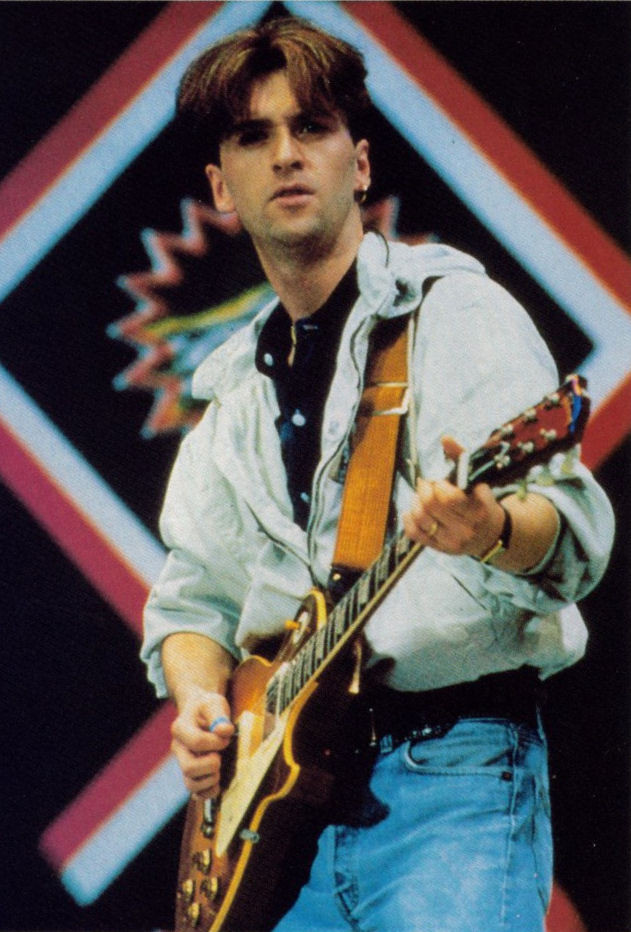 Johnny Marr playing his 1959 Gibson Les Paul during a Simple Minds performance in 1988.
Johnny Marr playing his 1959 Gibson Les Paul during a Simple Minds performance in 1988.
“Another main recording guitar is my ’59 Les Paul – just as you’d expect, an amazing guitar. I used that a lot on ‘Strangeways…'”
This 1959 Gibson Les Paul Standard, refinished in sunburst, is another prized possession. Given to Pete Townshend by Joe Walsh, it later found its way to Marr. He used it extensively on the Strangeways, Here We Come album and on tracks like “Panic,” “London,” “Ask,” and “Half A Person.” Its powerful, warm tone contrasts beautifully with the brighter Rickenbackers and Telecasters.
1985 Gibson Les Paul Standard (Wine Red with Bigsby)
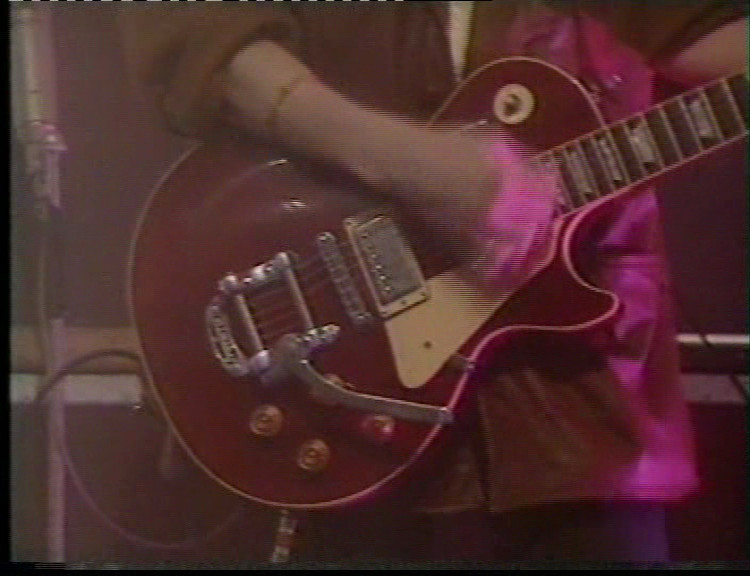 Johnny Marr playing his wine red 1985 Gibson Les Paul Standard with Bigsby.
Johnny Marr playing his wine red 1985 Gibson Les Paul Standard with Bigsby.
“My other Les Paul is a mid-’80s one with a Bigsby retro-fitted; that’s the one I used on ‘How Soon Is Now?’.”
Acquired for the Meat Is Murder tour, this wine red 1985 Les Paul Standard became crucial for achieving a harder sound. Marr retrofitted a Bigsby vibrato, Seymour Duncan pickups, and a coil tap. It was used on “How Soon Is Now?” and for writing songs like “Nowhere Fast” and “The Headmaster Ritual.” This guitar marked a shift towards a more aggressive Les Paul tone for Marr.
1972 Gibson Les Paul Custom (Black)
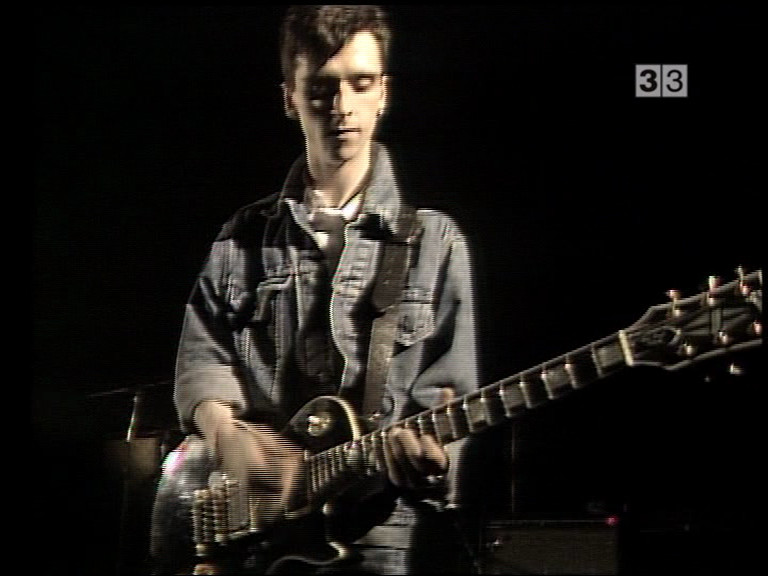 Johnny Marr playing his black 1972 Gibson Les Paul Custom.
Johnny Marr playing his black 1972 Gibson Les Paul Custom.
“I’ve got this black Les Paul that I wrote Bigmouth Strikes Again on, and The Queen Is Dead… and it’s on the whole of The Queen Is Dead, pretty much.”
This black 1972 Gibson Les Paul Custom was a major stage guitar in 1985 and a key instrument for The Queen Is Dead album, including the title track and “Bigmouth Strikes Again.” It features a mini-toggle switch, likely for coil-tapping, and a Gibson TP-6 tailpiece with fine tuners. Notably, Marr gifted this guitar to Noel Gallagher of Oasis in 1994.
Fender: Clarity and Twang
Fender guitars, particularly Telecasters and Stratocasters, provided Marr with brighter, more articulate tones, essential for certain Smiths tracks.
John Porter’s 1954 Fender Telecaster (Butterscotch Refinished)
“A lot of ‘The Smiths’ was actually recorded with a ’54 Telecaster belonging to John Porter. I used a Rickenbacker 360 12-string as well, and that was the guitar which subsequently got all the attention, but in fact it was mainly the Tele, and a bit of Les Paul.”
“This Charming Man” was the first record where I used those highlife-sounding runs in 3rds. I’m tuned up to F# and I finger it in G, so it comes out in A. There are about 15 tracks of guitar. People thought the main guitar was a Rickenbacker, but it’s really a ’54 Tele.”
Crucially, much of The Smiths’ signature guitar work wasn’t played on a Rickenbacker, but on producer John Porter’s refinished 1954 Fender Telecaster. This Telecaster is responsible for the iconic riff of “This Charming Man” and contributed to the chiming tones on many Smiths recordings. Porter himself emphasized the Telecaster’s prominent role, often overshadowing the perceived dominance of the Rickenbacker in the band’s sound.
Roger Giffin Custom Telecaster (Green Sunburst)
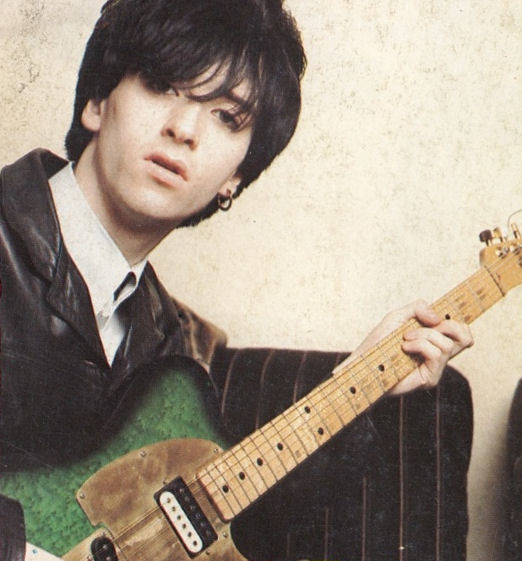 Johnny Marr playing his custom green Roger Giffin Telecaster.
Johnny Marr playing his custom green Roger Giffin Telecaster.
“I’ve got a Telecaster, made by Roger Giffin, which is a phenomenal guitar; it’s in a dark-green sunburst.”
This custom-made Roger Giffin Telecaster in dark green sunburst was used on Heaven Knows I’m Miserable Now and Strangeways, Here We Come. Giffin, known for building guitars for Pete Townshend, crafted this unique Telecaster, possibly acquired from Townshend’s collection through Alan Rogan. It features a humbucker in the neck position with a coil-tap switch, adding versatility to its Telecaster twang.
1962 Fender Stratocaster (White with Maple Neck, later Rosewood)
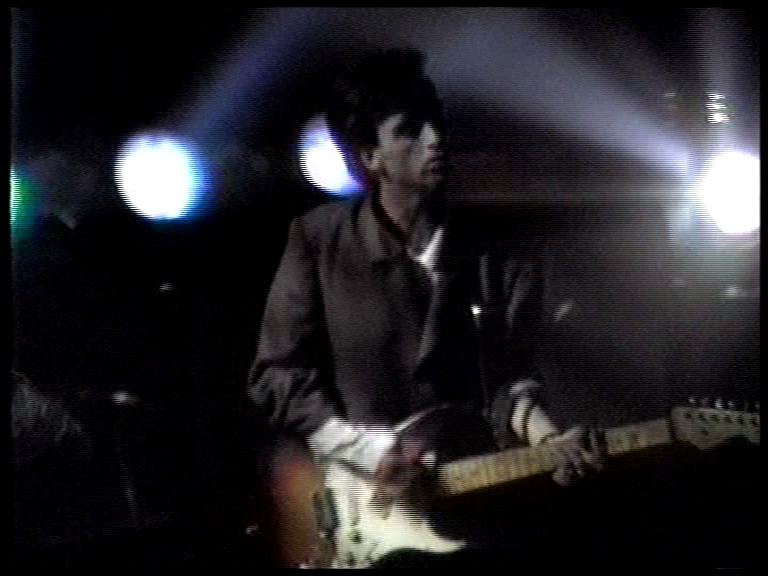 Johnny Marr playing his 1962 Fender Stratocaster with a maple neck in 1986.
Johnny Marr playing his 1962 Fender Stratocaster with a maple neck in 1986.
“I used this Fender Strat on the Smiths US and UK tours of 1986. It is a 1962 body with a 1963 neck. I used it to record ‘There Is A Light That Never Goes Out’, ‘I Know It’s Over’ and some others. This Strat had a maple neck when it was used with the Smiths. It was one of Johnny’s main guitars on the 1986 tours, and was used exclusively with a capo, for songs like “There Is A Light” and “Frankly, Mr. Shankly”.”
This white 1962 Fender Stratocaster (with a ’63 neck) was a main stage guitar for the 1986 tours. Used with a capo, it was essential for songs like “There Is A Light That Never Goes Out” and “Frankly, Mr. Shankly.” It was also used in the studio for tracks like “There Is A Light That Never Goes Out” and “I Know It’s Over.” Originally with a maple neck during The Smiths era, it later received a rosewood neck.
1963 Fender Stratocaster (White with Rosewood Neck)
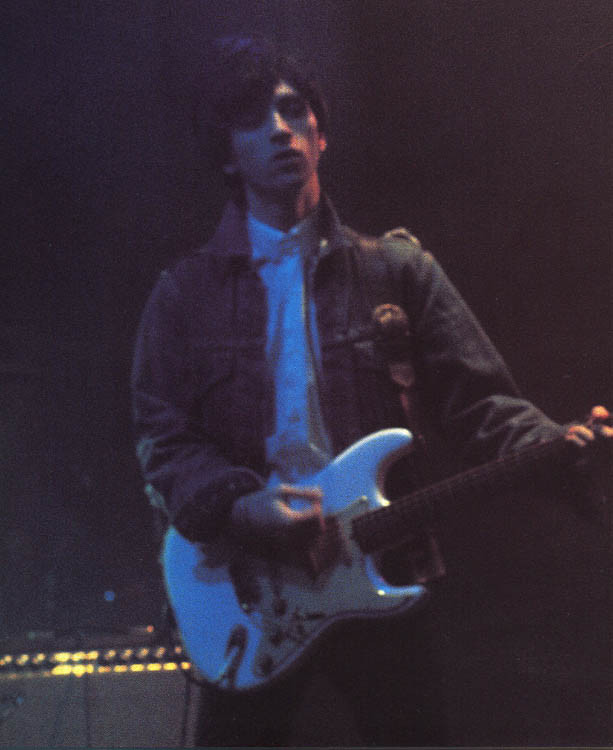 Johnny Marr playing his 1963 Fender Stratocaster at the Oxford Road Show in 1985.
Johnny Marr playing his 1963 Fender Stratocaster at the Oxford Road Show in 1985.
“It was very deliberate. It was right when I got a white Strat. I used it on [Unloveable] and I used it on “A Boy with A Thorn in His Side.” But “Unloveable” was the first time I deliberately used that Strat sound for a Smiths song.”
This other white 1963 Fender Stratocaster, differentiated by its rosewood neck and standard switch layout, debuted at the Oxford Road Show in 1985. It became another primary guitar on the 1986 tours, played in standard tuning without a capo. It contributed to tracks like “Unloveable” and “A Boy with A Thorn in His Side.” This Strat is notable for its customized electronics, featuring an additional 3-way switch, modifications done by its previous owner, Gary Shaughnessey of Sweet Sensation.
Gretsch: Early Tones and Open Tunings
Gretsch guitars played a significant role in the early days of The Smiths and for specific songs requiring unique tunings.
1970s Gretsch 7680 Super Axe
“Used on Smiths demos, early gigs, ‘Hand In Glove’. I had two Gretsch Super Roc Jets which were really cheap. I’ve had one for ages and I got a new one a couple of weeks ago. One of them’s got a phase unit and compressor built in. It has a solid body in the old conventional Gretsch shape with one cutaway and it’s really thin. I got a new one in a mink colour which hasn’t got the effects unit on. They look quite tacky but they’re good guitars to play and not that expensive, either.”
This 1970s Gretsch 7680 Super Axe, along with a 7685 Atkins Axe, were Marr’s initial Gretsch guitars. Used on early Smiths demos, gigs, and “Hand in Glove,” these guitars, despite being “tacky” and inexpensive, played a foundational role in the band’s formative sound. The Super Axe featured built-in effects, while the Atkins Axe lacked these.
Gretsch 6120 (Orange)
“The Gretsch 6120 that I used to write and record “Stretch Out And Wait”. You can hear it on “Is It Really So Strange?” too. I got it from The Who and It’s one of the best old 1960’s Gretsch’s that I’ve played. I got introduced to a guy called Alan Rogan who used to work for Townshend, Clapton and Keith Richards. I ended up getting a load of guitars off him. That’s where the Gretsch 6120 came in. It’s the one Townshend played on loads of Who stuff. I don’t know why he sold it to a geek like me.”
This Gretsch 6120, acquired from Pete Townshend, was used for writing and recording “Stretch Out And Wait” and “Is It Really So Strange?”. Used in Open G tuning for “Meat Is Murder” tour performances, it highlights Marr’s exploration of different tunings and tones within The Smiths’ sound.
Epiphone: Hollow-Body Vibrations
Epiphone guitars provided Marr with hollow-body tones, notably for the tremolo-laden sound of “How Soon Is Now?”.
1963 Epiphone Casino (Sunburst)
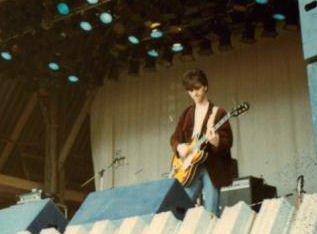 Johnny Marr playing a sunburst Epiphone Casino guitar at Glastonbury in 1984.
Johnny Marr playing a sunburst Epiphone Casino guitar at Glastonbury in 1984.
“The 1963 Epiphone Casino that I used to record the main tremolo sound on ‘How Soon Is Now’. I recording the rhythm part and then sent the track out to four Fender Twin Reverbs all with tremolo on and had to keep stopping the song when the amps went out of sync. It took quite a long time. I wrote ‘Nowhere Fast’ on this guitar and played it at the Glastonbury Festival in 1984. The picture on the inside of Hatful Of Hollow was taken in the dressing room before we went on stage so I have the guitar on in that picture. I’ve also got an old Epiphone Casino. That’s one of my favorites.”
The 1963 Epiphone Casino is famously associated with the tremolo-drenched sound of “How Soon Is Now?”. Marr utilized its hollow-body resonance and P90 pickups to create the song’s iconic vibrato effect, achieved by routing the Casino through multiple Fender Twin Reverbs with tremolo engaged. He also wrote “Nowhere Fast” on this guitar and played it at Glastonbury in 1984.
1962 Epiphone Coronet (Cherry)
“This is a 1962 Epiphone Coronet. Shortly after I got it I put it in ‘Nashville Tuning’, which means putting on an electric 12 string set (the bottom four strings are an octave higher than standard). It feels like your playing backwards because the higher strings are at the bottom. I used it to double a lot of the Rickenbacker arpeggios on Smiths records, most notably on ‘William It Was Really Nothing’, it’s also the main guitar on ‘Half A Person’.”
This 1962 Epiphone Coronet, tuned to Nashville tuning, contributed a unique high-pitched shimmer to The Smiths’ recordings. Used to double Rickenbacker arpeggios, it is prominently featured on “William It Was Really Nothing” and is the main guitar on “Half a Person.” Its zingy, trebly character, resulting from the Nashville tuning, added another layer to Marr’s textural guitar arrangements.
Acoustic Guitars: Foundation for Melodies
Acoustic guitars were essential for songwriting and for adding depth to certain Smiths tracks.
1972 Martin D-28
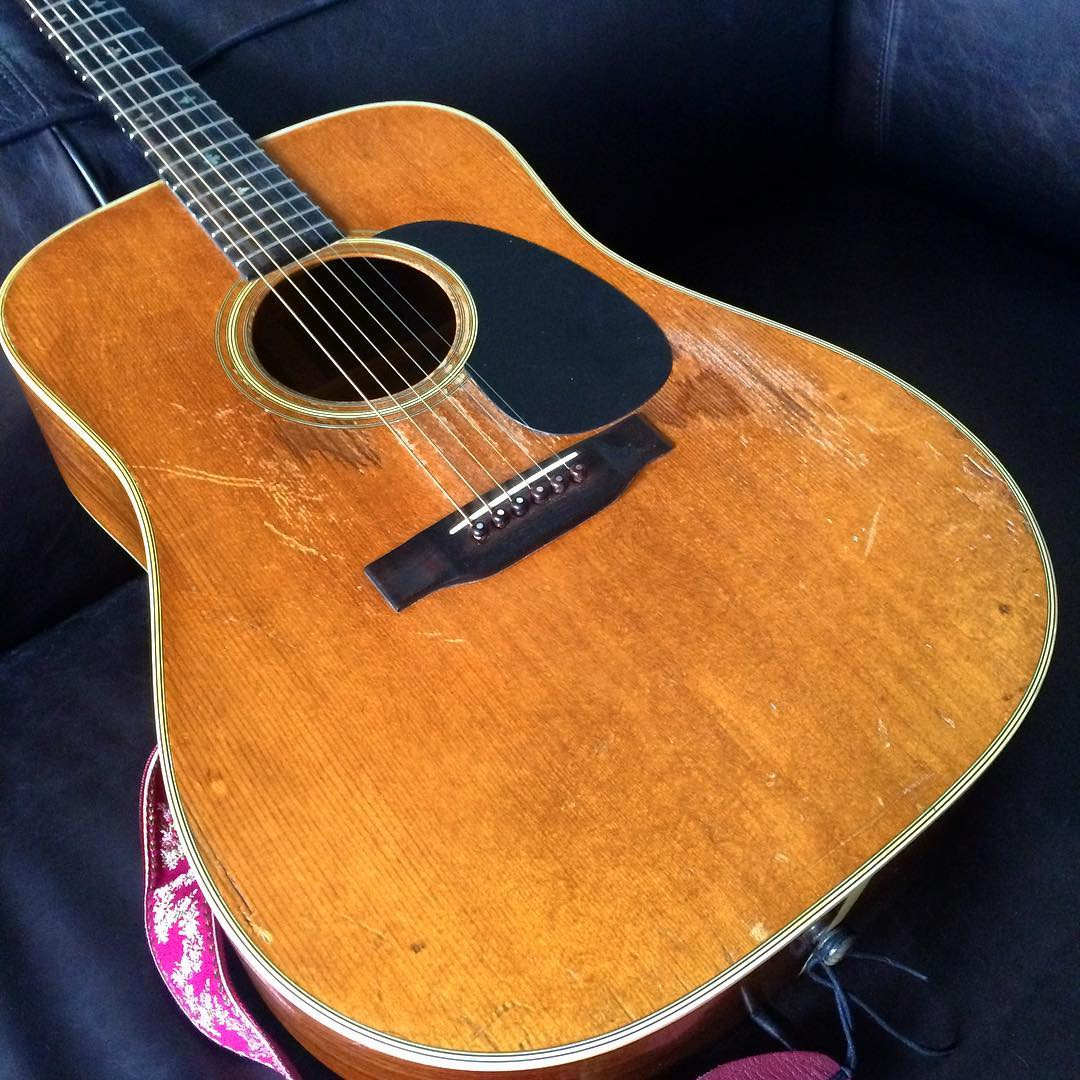 Johnny Marr's 1972 Martin D-28 acoustic guitar, used for writing and recording many Smiths classics.
Johnny Marr's 1972 Martin D-28 acoustic guitar, used for writing and recording many Smiths classics.
“Smiths main acoustic. Martin D28. Well I Wonder, There Is A Light, Bigmouth Strikes Again, I Know It’s Over.”
This 1972 Martin D-28 was The Smiths’ primary acoustic guitar, used for songwriting and recording numerous classics, including “There Is A Light That Never Goes Out,” “Well I Wonder,” “Bigmouth Strikes Again,” and “I Know It’s Over.” Its rich, full tone provided the foundation for many of the band’s most poignant melodies. Marr wrote “The Headmaster Ritual” on acoustic guitar, using open-D tuning with a capo at the 2nd fret, recording two tracks of the D-28 for the song.
Martin D-28 12 String Acoustic
“The Martin twelve string that I used on ‘Unhappy Birthday’ and ‘Bigmouth Strikes Again’ by The Smiths.”
This Martin D-28 12-string acoustic added a lush, expansive sound to tracks like “Unhappy Birthday” and “Bigmouth Strikes Again.” Its 12 strings provided a chorus-like texture, enhancing the emotional depth of these songs.
Early 1970s Martin D45
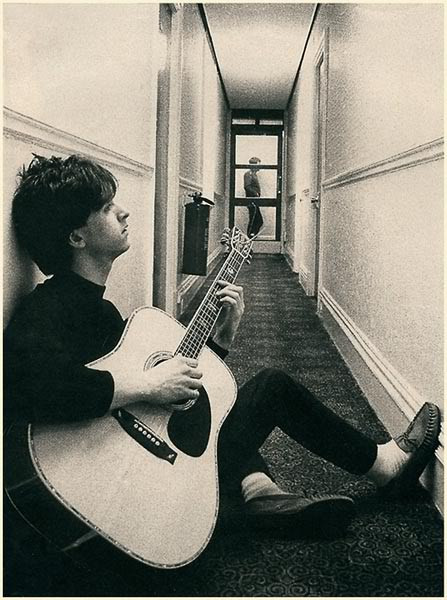 A 1970s Martin D-45 acoustic guitar, similar to Johnny Marr's model.
A 1970s Martin D-45 acoustic guitar, similar to Johnny Marr's model.
“Used on ‘Back To The Old House’.”
This early 1970s Martin D-45 was used specifically for “Back To The Old House,” contributing its warm and intimate tone to the song’s delicate atmosphere.
Martin D35
“I’ve had this guitar longer than any other. It cost me £900 in the early Eighties, which was a fortune back then. I wrote quite a few Smiths songs on this, including Well I Wonder and Cemetery Gates.”
Marr’s Martin D-35 is his longest-held guitar, purchased in the early 1980s. It was used to write several Smiths songs, including “Well I Wonder” and “Cemetery Gates,” demonstrating its importance in his songwriting process.
Gibson J160E
“I got this J160 from Denmark Street when I moved to Earl’s Court in 1984. I wanted one because John Lennon used one on the early Beatle’s albums and I liked ‘I Should’ve Known Better’ and ‘I’ll Be Back’. I wrote ‘Please Please Please Let Me Get What I Want’ on it and ‘William It Was Really Nothing’.”
Inspired by John Lennon’s use of the Gibson J160E, Marr acquired one in 1984. He used it to write iconic Smiths ballads like “Please Please Please Let Me Get What I Want” and “William It Was Really Nothing,” highlighting its suitability for softer, melodic songwriting.
Amplifiers: Shaping Marr’s Guitar Tone
Marr’s amplifier choices were as crucial as his guitars in achieving his signature sound. He favored Fender and Roland amps for their distinct characteristics.
Fender Twin Reverb
“With my amp set up, the Rickenbacker’s just perfect as it goes through a Fender twin and a JC120. The Fender twin has got loads of power and that handles the bottom to mid range. The Fender has also got the best reverb, so I just let the Roland handle the top end most of the time; it’s a dream and sounds great. It’s something that I wanted to get together for a long time. On the first long British tour I used either one or the other depending on what sounded good in the sound check. When I listen to some of the live tapes now I think they could have been so much better if I’d just used a Fender twin. If I had the choice between one or the other I’d think I’d use the Fender twin with a really good Roland chorus pedal.”
The Fender Twin Reverb was a cornerstone of Marr’s amp setup. He praised its power and ability to handle the bottom and mid-range frequencies, as well as its excellent reverb. He often paired it with a Roland Jazz Chorus 120, using the Fender for warmth and body and the Roland for top-end clarity and chorus. He used both Silverface and Blackface Twin Reverbs throughout his Smiths career.
Roland Jazz Chorus 120 (JC-120)
“Overall, what I really didn’t like about the records then was the amp, the Roland Jazz Chorus.”
Despite later expressing some dissatisfaction with the Roland Jazz Chorus for recordings, the JC-120 played a vital role in Marr’s live sound. He utilized its pristine clean tone and built-in chorus, often in conjunction with a Fender Twin Reverb. While he felt it lacked warmth on recordings, its clarity and chorus effect were crucial components of his live guitar rig.
Fender Pro Amp & Bandmaster
“I also used a Fender Pro a lot – that was also on a lot of the early Smiths records, while my Blackface Twin was used from the Queen Is Dead onwards.”
The Fender Pro Amp was another amp used on early Smiths records, offering a different flavor of Fender tone. Later, a Blackface Twin Reverb became his main Fender amp from the Queen Is Dead era onward. He also used a Fender Bandmaster, particularly in later Smiths tours, often paired with the JC-120.
Other Amplifiers
Marr experimented with other amplifiers, including:
- Fender Deluxe Reverb: Seen with a 2×12 cabinet in 1987.
- Fender Vibroluxe: Used in 1987.
- Vox AC30: Used in conjunction with an Ibanez CS-505 chorus in 1985.
- Mesa Boogie Mk III & Mk I: Used in 1986, often alongside Fender and Roland amps.
Effects Pedals and Rack Units: Adding Texture and Depth
Effects were integral to Johnny Marr’s guitar sound, adding shimmer, modulation, and spatial depth. Boss pedals and Korg delays were prominent in his setup.
Chorus Pedals: The Shimmering Foundation
Chorus was a signature effect for Marr, adding a shimmering, ethereal quality to his guitar tone.
- Boss CE-2 Chorus:
“[The JC-120] has a really good chorus and I’m never without it really. I used to use a couple of chorus pedals. … I used to love the white GE-6 equalizer, and the very first light-blue CE-2 chorus that still sounds really good.”
The Boss CE-2 Chorus was a constant in Marr’s pedalboard, both live and in the studio. He valued its warm, lush chorus effect, often using it in conjunction with the JC-120’s built-in chorus. He also used older Roland stereo-split chorus units in the studio.
- Ibanez CS-505 Chorus: Used in 1985, often paired with a Vox AC30.
Overdrive and Distortion
Marr used subtle overdrive and distortion to add grit and sustain when needed.
- Boss OD-2 Overdrive:
“I had the yellow [BOSS] OS-2 overdrive/distortion pedal, the OD-2 Overdrive pedal; actually thats where I got the riff to The Smiths song ‘London’. … I had the CE-2 chorus pedal, the white GE-6 EQ, the BF-2 purple flanger and when the very first grey reverb pedal came out, the RV-2, I got that. I still own it. It sounds really good.”
The Boss OD-2 Overdrive was used by Marr, and he credited it as the inspiration for the riff of The Smiths’ song “London.” He also mentioned using an OD-1 in some 1984 shows.
-
Boss OS-2 Overdrive/Distortion: While mentioned in a quote, the OS-2 was released after The Smiths era, so its use with the band is unlikely.
-
Boss HM-2 Heavy Metal: Visible on his pedalboard from a 1986 Nottingham gig.
Equalization and Tone Shaping
- Boss GE-6 Equalizer:
“I went back to some of my old stomp boxes that I had when I was in The Smiths, most of which were Boss. I used to love the white GE-6 equalizer, and the very first light-blue CE-2 chorus that still sounds really good.”
The Boss GE-6 Equalizer was cherished by Marr for its tone-shaping capabilities. He used the white GE-6 extensively to fine-tune his guitar sound.
Delay Units: Creating Space and Texture
Delay was essential for Marr’s more atmospheric and experimental guitar parts, particularly for “How Soon Is Now?”.
- Korg SDD Series Digital Delays (1000, 2000, 3000):
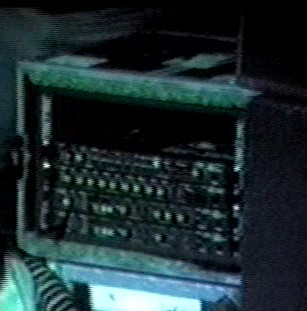 Johnny Marr's rack setup circa 1986, featuring Korg SDD series digital delays.
Johnny Marr's rack setup circa 1986, featuring Korg SDD series digital delays.
“I’ve actually started using a digital delay line, just because for one song in particular I needed to use it. I just sent the effect straight through the Fender twin. The song is the ‘B’ side of the twelve-inch ‘William, It Was Really Nothing’ and it’s called ‘How Soon Is Now?’ which is a ‘Bo Diddley’ thing, so I had to have the vibrato. I sent all the signal through the Fender twin and just put straight guitar through the Roland. I just stuck a slide on and it worked. I was a little bit worried because it was difficult to play. For the first time I’d done something really tricky in the studio which I had to reproduce live.”
Korg SDD series digital delays became a central part of Marr’s rack setup by 1986. He used multiple units (SDD-1000, SDD-2000, and two SDD-3000s), notably for creating the looped slide guitar part in “How Soon Is Now?”. He also utilized delay for harmonizing solos, as heard in live performances of “Never Had No One Ever.”
- Bel BD40 Delay: Used in 1985, particularly on US tour dates.
Other Effects
-
Boss TW-1 Touch Wah: Visible on his pedalboard from a 1986 Nottingham gig.
-
Boss BF-2 Flanger: Mentioned by Marr as part of his pedal collection from The Smiths era.
-
Boss RV-2 Reverb: While released after The Smiths’ active period, Marr mentioned owning and liking the RV-2 reverb pedal.
-
Roland Stereo-Split Chorus/Vibrato (Studio Use): Used in the studio, this unit had separate chorus and vibrato effects, which Marr utilized extensively.
-
Wah Pedal: Marr used wah pedals, employing them more as a tone control than for typical wah effects.
Strings, Slides, and Capos
-
Strings: Ernie Ball strings, gauged .010 to .046, were Marr’s preferred choice for most of his guitars.
-
Slides: Chrome slides, shorter versions, were used, notably for the slide guitar part in “How Soon Is Now?”.
-
Capos: Dunlop capos were his standard choice. Capos were frequently used, often tuned up to F# or capoed at the 4th fret in standard tuning, contributing to the bright, jangly character of many Smiths songs.
Conclusion: The Art of Johnny Marr’s Guitar Sound
Johnny Marr’s guitar sound is a testament to his meticulous approach to gear and his innovative playing style. By carefully selecting a diverse range of guitars, amplifiers, and effects, he crafted a unique and influential sonic landscape for The Smiths. From the iconic Rickenbacker jangle to the warm depth of Gibson Les Pauls and ES-355s, and the articulate twang of Fender Telecasters and Stratocasters, each instrument played a crucial role. His strategic use of effects, particularly chorus and delay, further shaped his signature sound. This detailed exploration into Johnny Marr’s guitars and equipment provides valuable insight into the techniques and tools behind one of indie music’s most distinctive guitar voices.

